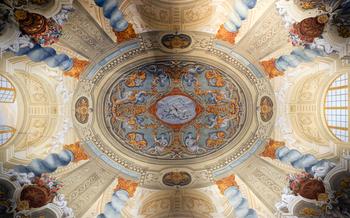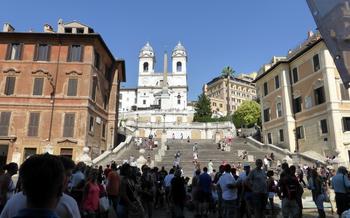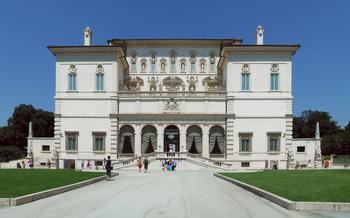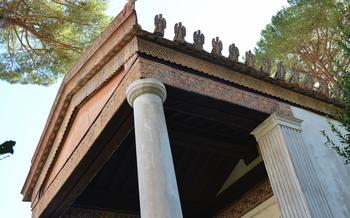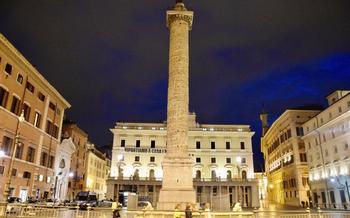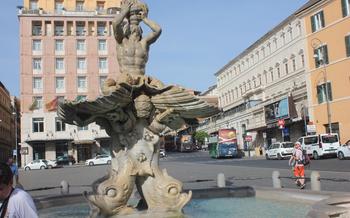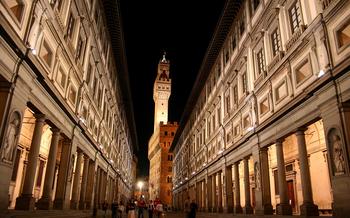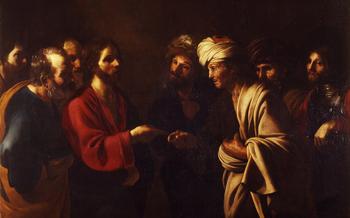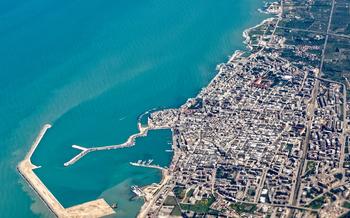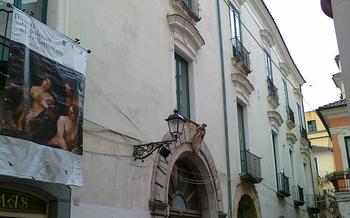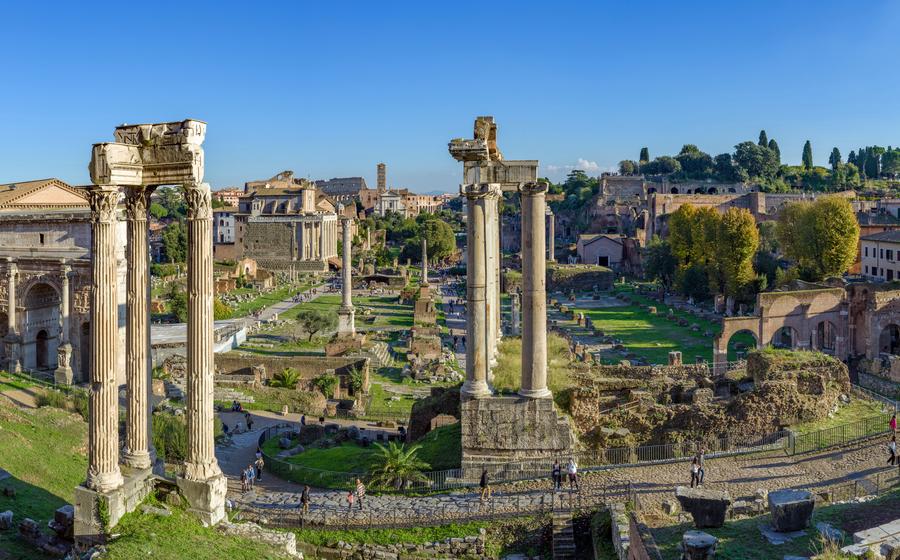
Capitoline Museums
- Introduction
- History
- Location
- Collections
- Highlights
- Exhibitions
- Guided Tours
- Accessibility
- Amenities
- Admission
- Hours of Operation
- Photography
- Tips for Visiting
- Nearby Attractions
- Insider tip
- Insider Tip
Introduction
In the heart of Rome, atop the Capitoline Hill, stands a treasure trove of art and history known as the Capitoline Museums. These venerable institutions, among the world's oldest public museums, offer a remarkable journey through time, showcasing an extraordinary collection of ancient sculptures, paintings, and artifacts that tell the story of Rome's glorious past. Founded in the 15th century by Pope Sixtus IV, the Capitoline Museums have been enriched over the centuries by successive popes and collectors, transforming them into a repository of artistic and cultural heritage of unparalleled significance. Prepare to be awed as you wander through the grand halls and galleries, encountering masterpieces that have left an indelible mark on the history of art and civilization.
History
The Capitoline Museums, among the oldest and most important museums in the world, owe their origins to Pope Sixtus IV, who in 1471, donated a series of bronze statues to the people of Rome, including the celebrated "She-wolf", the symbol of the city. The sculptures were placed on the Campidoglio, the Capitoline Hill, the political and religious center of ancient Rome, in order to inspire civic pride and virtue in the Roman people. The collection was enriched over the centuries with other donations and acquisitions and in 1734, Pope Clement XII opened the Capitoline Museums to the public, making them the first public museums in the world. The museums were later expanded and reorganized, and in 1997, they were extensively restored and modernized, becoming one of the most visited museums in Rome.
Location
The Capitoline Museums are located on the Capitoline Hill in Rome, Italy. The hill is one of the seven hills of Rome, and it has been the site of important government buildings since ancient times. The museums are housed in two palaces: the Palazzo dei Conservatori and the Palazzo Nuovo. The Palazzo dei Conservatori is the older of the two palaces, and it was built in the 16th century. The Palazzo Nuovo was built in the 17th century.
The Capitoline Museums are easy to get to by public transportation. The nearest metro station is Colosseo, and it is a short walk from the station to the museums. The museums are also accessible by bus. Several bus lines stop near the museums, including the 40, 64, and 8
If you are coming to the museums by car, there is a parking garage nearby. The garage is located on Via di San Pietro in Carcere, and it is a short walk from the museums.
Collections
The Capitoline Museums house a diverse and impressive collection of ancient sculptures, paintings, and other works of art. The ancient sculpture collection is particularly noteworthy, with masterpieces such as the bronze statue of Marcus Aurelius and the Capitoline Venus. Other highlights include the Dying Gaul, the Spinario, and the Capitoline Wolf.
The museum also houses a significant collection of medieval and Renaissance art, including works by Caravaggio, Bernini, and Raphael. The picture gallery, which is located in the Palazzo dei Conservatori, features paintings from the 13th to the 19th centuries. Some of the most famous works in the collection include Caravaggio's The Fortune Teller and Bernini's Apollo and Daphne.
In addition to its art collections, the Capitoline Museums also house a number of other fascinating artifacts, such as ancient coins, inscriptions, and mosaics. The museum also has a collection of Egyptian antiquities, including a statue of Ramses II and a sarcophagus from the 26th Dynasty.
Highlights
Among the many treasures housed in the Capitoline Museums, some stand out as must-sees for any visitor. The bronze statue of Marcus Aurelius is one of the most famous and iconic sculptures in the world. Originally located on the Campidoglio, it was moved to the museums in the 16th century. Depicting the Roman emperor on a horse, it is a masterpiece of ancient art and exemplifies the skill and artistry of the period.
Another highlight is the Capitoline Venus, a marble statue of the goddess Venus. Discovered in the 17th century, it quickly became one of the most admired and influential statues of the Roman era. The statue is a splendid example of the Classical style, with its elegant lines and graceful pose. Its beauty and majesty continue to captivate visitors to this day.
Finally, the museums are home to a collection of ancient mosaics, which are among the finest examples of this art form. The mosaics depict various scenes and subjects, from mythology to history, and offer a glimpse into the artistic and cultural traditions of the Roman world. They are a testament to the skill and creativity of ancient artisans and provide a unique perspective on Roman art and culture.
Exhibitions
The Capitoline Museums are frequently the seat of extraordinary temporary exhibitions. From time to time, some of the museum's most fascinating and recognizable artworks are displayed alongside well-known masterpieces from all over the world. These events are held in conjunction with renowned cultural institutions and offer a unique opportunity to admire the works of great masters.
The museum also frequently hosts events, meetings, and temporary displays that explore specific subjects or focus on particular artistic periods. For example, in recent years there have been exhibitions on the Venetian School, Neapolitan painting, and collections and collectors from all over Italy.
Admission to these temporary exhibitions is generally included in the entrance fee to the museum and is a great chance for art enthusiasts to see famous paintings and sculptures from all over the world. Interested visitors should check out the museum's official website or the exhibition's social media channels to find out what's currently on display.
Guided Tours
Guided tours of the Capitoline Museums are available in various languages, including English, Italian, French, Spanish, and German. These tours typically last between 5 and 2 hours and provide visitors with an in-depth overview of the museums' history, collections, and highlights. Guided tours can be booked online or by phone, as well as in person at the museums' ticket office. The price of a guided tour is generally higher than the price of admission, but it is worth the extra cost for those who want to learn more about the museums and their treasures.
Accessibility
The Capitoline Museums are committed to providing access to all visitors. The museums are wheelchair accessible, and wheelchairs can be borrowed for free at the information desk. There are also elevators and ramps throughout the museums, making it easy to get around. Visitors with disabilities can also request a sign language interpreter or a tour guide who can provide audio descriptions of the works of art.
Amenities
The Capitoline Museums offer a range of amenities to enhance visitors' experiences. The on-site Caffetteria del Campidoglio provides a delightful setting to savor delectable Italian snacks and beverages while admiring the breathtaking views of the city from its panoramic terrace. Whether seeking a quick bite or a relaxing break, the cafeteria offers a delightful respite from exploring the museums' treasures.
For those wishing to delve deeper into the history and significance of the artwork, audio guides are available in several languages. These informative companions provide insightful commentary and explanations, allowing visitors to uncover the stories and symbolism hidden within the ancient masterpieces.
For those seeking tangible mementos of their visit, the museums feature two gift shops. Located on the ground floor of the Palazzo dei Conservatori and the Palazzo Nuovo, these shops offer a diverse selection of souvenirs, including books, postcards, replicas of sculptures, and other unique items inspired by the museums' collections.
Finally, restrooms are conveniently located throughout the museums, ensuring visitors' comfort and convenience as they navigate the extensive galleries and exhibitions.
Admission
General admission: €15 per person (2022 prices).
Reduced admission: - €13 for visitors between the ages of 18 and 25 (upon showing a valid ID) - €2 for visitors who are residents of Rome or the Lazio region (upon showing a valid ID) - Free for visitors under the age of 18 - Free for visitors with disabilities and their companion (upon showing a valid disability card)
Free admission: - The first Sunday of every month - On December 24th and 25th, January 1st, May 1st, and June 2nd.
Hours of Operation
The Capitoline Museums are open every day except for Monday, from 9:30 am to 7:30 pm. Last entry is 30 minutes before closing. The museums are also closed on certain public holidays, so it is advisable to check the website before planning a visit.
The Capitoline Museums offer a variety of temporary exhibitions throughout the year, which may have different hours of operation. It is recommended to check the museum's website before visiting for the most up-to-date information on hours of operation and any special exhibitions.
Photography
Photography and videography are allowed in the Capitoline Museums, but there are some restrictions. Flash photography is not permitted, as it can damage the artworks. Tripods and selfie sticks are also not allowed. Visitors are asked to be respectful of other visitors and to avoid taking photographs that could disturb them.
The museum has a number of rules and regulations regarding photography and videography. These rules are in place to protect the artwork and to ensure that all visitors have a positive experience.
Be sure to read and understand these rules before you visit the museum. This will help you to avoid any problems and will ensure that you have a great time.
Here are some additional tips for taking photographs in the Capitoline Museums:
- Use a wide-angle lens. This will help you to capture more of the artwork in your photographs.
- Use a tripod. This will help you to stabilize your camera and take sharp photographs.
- Take your time. Don't rush through the museum. Take your time to look at the artwork and to compose your photographs.
- Be respectful of other visitors. Avoid taking photographs that could disturb other visitors.
Tips for Visiting
The Capitoline Museums are very popular, so it's important to plan your visit in advance. Arrive early to avoid crowds, especially during the high season (March - September). To fully appreciate the collections and avoid long lines, you can join a guided tour. Wear comfortable shoes as the museums are spread over several buildings and require a lot of walking. Bring a camera to capture the stunning works of art and sculptures. Take advantage of the audio guide to learn more about the history and significance of the exhibits. Visit the museums on the first Sunday of each month to enjoy free admission. Book combined tickets that give you access to the museums and other nearby attractions, such as the Roman Forum and the Colosseum. Combine your visit with a meal at one of the many nearby restaurants to soak up the Roman atmosphere. The museums are closed on Mondays and public holidays. Free Wi-Fi is available throughout the museums. The cafes and gift shops offer a selection of souvenirs, snacks and drinks. Remember, it's impossible to see all of the museums in one day. So, plan your visit and focus on the collections you're most interested in.
Nearby Attractions
The Capitoline Museums are ideally situated in the heart of Rome, next to the Piazza Venezia and the Roman Forum, allowing swift access to additional significant destinations within comfortable walking distance. Prioritize a stop at the Piazza del Campidoglio, boasting Michelangelo's extravagant design. Constructed in the 16th century, this grandiose square showcases the Palazzo Senatorio, the Capitoline Museums' neighbor, and the Palazzo dei Conservatori, which possesses an impressive art gallery.
Admire the awe-inspiring structure of the Colosseum and venture inside to understand the gladiator's battles and ancient Roman customs. Reach higher ground on the Palatine Hill, Rome's birthplace, and wander amidst lingering ruins. Discover the mysteries of the Roman Forum, where politics, commerce, and religion merged to determine the city's pulse. Do not miss the Pantheon, an inspiring architectural marvel dedicated to the Roman deities, its magnificent dome projecting an aura of otherworldly elegance. Embark on a pilgrimage through art history at the Galleria Borghese, home to masterpieces by the likes of Bernini, Caravaggio, and Raphael. Finally, climb the iconic Spanish Steps, culminating at the stunning Piazza di Spagna, where you can savor the surrounding lively atmosphere and delve deeper into Rome's captivating essence.
Insider tip
While in the neighborhood, don't miss the opportunity to try some of the local delicacies. Head to the nearby Campo de' Fiori market, where you can indulge in fresh fruits, cheeses, and meats. For a delicious meal, try the traditional Roman dish, pasta alla carbonara, at one of the many restaurants in the area.
Insider Tip
In the Palazzo dei Conservatori, there is a secret room known as the "Tabularium". This room was once used to store the bronze tablets on which the laws of ancient Rome were inscribed. Today, it is open to the public and offers visitors a glimpse into the history of Roman law. To find the Tabularium, look for the small door next to the room that houses the Capitoline Venus.
